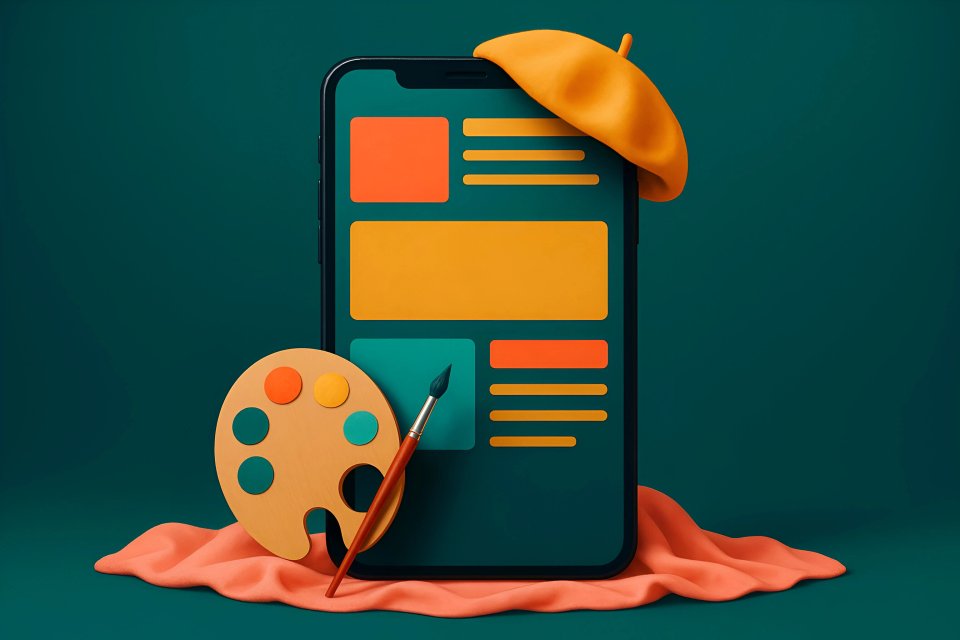Is your website a ghost town despite a flood of visitors? You pour money into ads, drive traffic, but the needle on sales barely twitches. It’s a gut-wrenching feeling, watching potential customers slip through your fingers, your hard-earned marketing dollars vanishing into thin air. You’re not alone in this struggle; many businesses face this conversion crisis, wondering where they’re going wrong.
But what if I told you the key to unlocking those conversions, to transforming casual browsers into loyal customers, lies in a simple, profound shift in perspective? It’s time to stop shouting into the void and start listening, really listening, to your users. The solution is user-centric UI/UX design, a strategy no longer optional but absolutely essential for conversion rate optimization. Studies even show that empathetic, iterative design processes can lead to staggering increases of up to 400% in conversion rates (Source: UX Planet, ProfitOptics).
This isn't just another article filled with jargon. We're going to break down, step-by-step, how strategic UI/UX can revolutionize your visitor interactions, turning clicks into commitments. We’ll explore how to blend stunning aesthetic appeal with the kind of intuitive functionality that makes your users feel understood, valued, and eager to take the next step. At CaptivateClick, our philosophy is built on this foundation: creating designs that don't just look good, but perform by putting your user at the very heart of everything we do, embodying captivating design and strategic marketing.
Understanding the Fundamentals: UI, UX, and User-Centricity
So, what’s the magic behind these terms – UI, UX, and user-centricity? Let's demystify them, because understanding these fundamentals is your first step towards a website that doesn't just attract, but converts. You need to know the battlefield before you can win the war for customer attention and action.
First, let's talk about UI (User Interface) Design. Think of this as the "look and feel" of your digital product. It’s the colors that evoke emotion, the buttons that invite a click, the typography that guides the eye – essentially, all the visual elements and interactive components your user sees and touches. A beautiful UI can certainly attract, but beauty alone won't keep them there or make them act.
Next up is UX (User Experience) Design. This is the bigger picture, the overall feeling a user gets when interacting with your site or app. Is it easy to use? Can they find what they need without a Ph.D. in navigating your menus? Do they leave feeling satisfied, or frustrated and confused? As the Nielsen Norman Group aptly puts it, UX encompasses all interactions, emphasizing ease of use, efficiency, and emotional satisfaction.
Now, what makes design truly "User-Centric"? It’s about deep empathy – genuinely understanding your users' needs, their unspoken frustrations, and their ultimate goals. It involves an iterative process of research, design, testing, and refining, never assuming you know best. And crucially, it means designing for accessibility, ensuring everyone, regardless of ability, can have a positive experience. This deep empathy, achieved through iterative research and testing, is the cornerstone of effective design, as highlighted by experts at Nomensa and the Nielsen Norman Group. The direct link is undeniable: a seamless, intuitive, and satisfying user experience naturally guides users towards your conversion goals, making them want to engage. In fact, Forrester Research quantifies the potential ROI of UX investment at an astounding 9,900%, underscoring its immense strategic value.
Key User-Centric UI/UX Principles for Skyrocketing Conversions
Ready to transform your website from a digital brochure into a conversion machine? It’s time to dive into the core principles that will make your users feel like your site was built just for them. These aren't just "nice-to-haves"; these are the battle-tested strategies that separate the businesses thriving online from those merely surviving.
Crystal-Clear Navigation & Information Architecture
Imagine walking into a massive library with no signs, no catalog, and books scattered everywhere. Frustrating, right? That’s what users feel with poor website navigation. Crystal-clear navigation and logical information architecture mean intuitive menus, a sensible site structure, and helpful breadcrumbs that tell users exactly where they are.
The impact on conversions is immediate and powerful. When users can find what they need quickly and effortlessly, bounce rates plummet, and frustration evaporates. According to CareerFoundry, effective information architecture can reduce user effort by a significant 40%. Furthermore, combining clear navigation with breadcrumbs can slash bounce rates by 19%, keeping users engaged and moving towards your goals.
This clarity ensures users don't just land on your site; they stay, explore, and ultimately, convert. It’s about making their journey to "yes" as smooth as silk.
Compelling & Unambiguous Call-to-Actions (CTAs)
Your Call-to-Action is the pivotal moment where interest turns into action. Is yours a timid whisper or a confident command? Compelling CTAs are visually prominent, using action-oriented language that creates urgency and desire, like Get Your Free Quote Now or Unlock Exclusive Access.
Placement is just as critical; CTAs must appear strategically within the user's natural flow, right when they're most receptive. The conversion impact? You clearly guide users to the next desired step, eliminating confusion and hesitation. HubSpot's analysis reveals that action-oriented CTAs with first-person pronouns, such as "Start My Free Trial," convert an impressive 34% better than passive alternatives. Moreover, ensuring a color contrast ratio of at least 4.5:1 between your CTA button and its background can increase conversions by 17%, making it pop for all users (Source: Coveo, CommerceGurus).
Don't let a weak CTA be the leaky faucet in your conversion pipeline. Make it bold, make it clear, and watch your engagement soar. For more insights, explore Effective Conversion Optimization: Design and Content Strategies That Work.
Mobile-First & Responsive Design
Are you still treating mobile users as an afterthought? Wake up! The majority of web traffic now comes from smartphones and tablets. A mobile-first and responsive design ensures a flawless, intuitive experience across all devices, from the largest desktop monitor to the smallest phone screen.
This isn't just about looking good; it's about survival and growth, especially for e-commerce and lead generation. Consider this: a staggering 63% of mobile users will abandon a site due to preventable usability issues, according to Baymard Institute. Conversely, embracing modern approaches like Progressive Web Apps (PWAs) can lead to a 41% increase in mobile conversions, thanks to faster load times and app-like experiences (Source: Baymard Institute, Google Developers).
Catering to your mobile audience isn't a luxury; it's a fundamental requirement for maximizing conversions. Dive deeper into crafting these experiences with insights from our articles on Mobile-First Web Design Trends for 2025 and Effective Strategies for Crafting Intuitive Mobile App UI/UX Designs.
Optimized Page Speed & Performance
Tick-tock... Can you hear that? It’s the sound of your potential customers leaving because your site is too slow. In today's fast-paced digital world, patience is a virtue few possess online. Optimized page speed and performance are non-negotiable for keeping users engaged and search engines happy.
The cost of slow loading times is immense: higher bounce rates, frustrated users, and plummeting conversion rates. Techniques like image optimization, writing efficient code, and choosing good hosting are your weapons in this fight for speed. Google's Core Web Vitals, for instance, mandate a Largest Contentful Paint (LCP) under 2.5 seconds, a threshold that correlates with 76% lower bounce rates (Source: Google Developers). Simple changes, like compressing images using WebP format, can reduce page weight by 45% without any noticeable quality loss (Source: Baymard Institute, Hotjar).
At CaptivateClick, our Performance Optimization services often tackle these very issues. Don't let speed bumps derail your customer's journey; learn more from our guides on Technical Optimization Best Practices for Faster Websites and The Ultimate Guide to Technical SEO for Web Performance Optimization.
Building Trust Through Design & Transparency
Would you hand over your credit card details to a shady-looking website? Of course not! Trust is the bedrock of any successful online transaction or interaction. Building trust through design and transparency involves professional aesthetics, easily accessible contact information, genuine testimonials or social proof, visible security badges (like SSL certificates), and clear, straightforward privacy policies.
The conversion impact is profound: it alleviates user concerns about security and legitimacy, making them far more comfortable to take that leap of faith – whether it's making a purchase, signing up for a newsletter, or requesting a quote. Displaying SSL/TLS certification badges can increase checkout completion rates by a significant 31% (Source: CommerceGurus). Furthermore, incorporating user-generated content like verified reviews can improve product page conversion rates by 18% (Source: CommerceGurus, Coveo).
A trustworthy design signals safety and professionalism, assuring users they're in good hands. Explore how to weave this into your site with insights on Combining User Experience and Branding in Website Design.
Streamlined Forms & Checkout Processes
Is your contact form longer than a tax return? Is your checkout process an obstacle course? Complex forms and convoluted checkouts are conversion killers, pure and simple. Streamlining these critical touchpoints means minimizing the number of fields, using clear labels, providing progress indicators, and offering guest checkout options for e-commerce.
This focus on simplicity directly reduces friction and abandonment at the most crucial points of conversion. Baymard Institute research shows that streamlined checkout processes with just 12-23 form elements can achieve 35% higher conversion rates. Even small details, like inline form validation with specific error messages (e.g., Please enter a valid email address), can decrease form abandonment by 22% compared to generic alerts (Source: Baymard Institute, Hotjar).
Make it easy for users to give you their information or their money. For e-commerce specific strategies, check out our posts on Expert Conversion Optimization Techniques for E-commerce Websites and Innovative E-Commerce Web Design Trends That Drive Sales. These are key areas where CaptivateClick's E-Commerce Web Design and Conversion Optimization services shine.
Readability & Visual Hierarchy
Can your users actually read your message, or is it lost in a sea of tiny text and confusing layouts? Readability and visual hierarchy are about making your content effortlessly digestible. This involves careful font choices, adequate contrast between text and background, generous spacing, and the strategic use of headings and subheadings to break up text.
The goal is to guide the user's eye naturally to the most important information – your key benefits, your unique selling propositions, and, critically, your calls to action. When key messages and CTAs are easily consumed, your conversion rates will thank you. For instance, Coveo reported a stunning 137% conversion lift achieved through improvements in visual hierarchy (Source: CommerceGurus, Coveo). Adhering to established patterns like the F-pattern for eye-tracking, as noted by the Nielsen Norman Group, ensures your layout aligns with how users naturally scan web pages.
Don't let poor readability sabotage your message. Ensure your design speaks clearly and persuasively.
The Process: Implementing User-Centric Design for Conversion Success
Knowing the principles is one thing; putting them into action is where the real magic happens. How do you actually implement user-centric design to achieve that coveted conversion success? It’s a systematic process, not a shot in the dark. Let’s walk through the essential steps.
Step 1: Deep User Research & Persona Development
Who are you really talking to? If you can't answer this with pinpoint accuracy, you're flying blind. Deep user research is about getting inside your target audience's head: Who are they? What are their deepest desires, their nagging pain points, their ultimate goals when they land on your site? Methods like surveys, one-on-one interviews, and meticulous analytics review are your tools for unearthing these golden nuggets of insight.
This research culminates in detailed user personas – fictional representations of your ideal customers. According to the Nielsen Norman Group, moderated usability tests can identify 85% of critical UX issues with as few as five participants, making qualitative research highly effective. The source material also highlights that robust persona development, segmenting users by variables like their tech savviness and psychological drivers, can lead to targeted design variations that improve lead quality by a remarkable 27%.
Step 2: Wireframing & Prototyping
With a clear understanding of your user, it's time to sketch the blueprint. Wireframing and prototyping involve mapping out user flows and screen layouts before you even think about colors or fonts. The focus here is purely on functionality, structure, and the intuitive pathways users will take to achieve their goals.
Think of wireframes as the skeleton of your website – basic, black-and-white outlines showing where key elements like navigation, content blocks, and CTAs will sit. Prototypes then add a layer of interactivity, allowing you to click through a simulated version of your site. This early-stage visualization helps identify potential roadblocks and usability issues long before costly development begins, ensuring a solid foundation for a high-converting design.
Step 3: Usability Testing
Assumptions are the enemy of good UX. You might think your design is the epitome of clarity, but what do real users think? Usability testing is where the rubber meets the road. It involves observing actual users as they attempt to complete specific tasks on your wireframes, prototypes, or live site.
This isn't about asking them if they "like" the design; it's about identifying friction points, areas of confusion, and moments of frustration. Tools like click heatmaps can be incredibly revealing; Hotjar, for example, notes how these can expose "rage-click" patterns on non-interactive elements, guiding redesigns that have been shown to reduce frustration-induced exits by as much as 33%. These insights are invaluable for refining your design to be truly user-friendly.
Step 4: A/B Testing & Continuous Iteration
Is that green button better than the blue one? Does "Get Started" outperform "Sign Up Now"? You don't have to guess. A/B testing (or split testing) allows you to test variations of design elements – CTAs, headlines, layouts, images – to see which version performs best in achieving your conversion goals.
User-centric design is not a one-time fix; it's an ongoing process of learning, adapting, and improving. The digital landscape changes, user expectations evolve, and your business grows. Continuous iteration, fueled by data from A/B tests and ongoing user feedback, ensures your website remains a powerful conversion engine. Optimizely's platform data suggests that for robust results, it's often better to test fewer variables sequentially rather than many at once, as testing more than three variables simultaneously can decrease statistical significance by 38%. This iterative approach is central to CaptivateClick's A/B Testing & Performance Tracking philosophy, ensuring your design continually adapts for maximum impact. For broader strategies, consider exploring Effective Conversion Optimization: Design and Content Strategies That Work.
Measuring the Impact: How User-Centric UI/UX Affects Your Bottom Line
All this effort in crafting a user-centric experience – what does it actually mean for your business? How do you know if it's working? The beauty of digital is that almost everything is measurable, and good UI/UX design has a direct, quantifiable impact on your bottom line.
Key Metrics to Track
Beyond the ultimate goal of Conversion Rate, several other Key Performance Indicators (KPIs) paint a clear picture of your UI/UX effectiveness. Are users fleeing your site in droves? Keep an eye on Bounce Rate. Are they sticking around and engaging? Average Session Duration will tell you. Can they actually achieve what they came to do? Task Completion Rate is crucial. And how do they feel about the experience? Customer Satisfaction Scores (like CSAT or Net Promoter Score - NPS) provide vital qualitative feedback.
Here's a quick look at some important metrics:
| Metric | What it Measures | Why it Matters for UI/UX |
|---|---|---|
| Conversion Rate | % of visitors completing a desired action | The ultimate measure of UI/UX success in driving goals. |
| Bounce Rate | % of visitors leaving after viewing only one page | High rates can indicate poor relevance or usability. |
| Average Session Duration | Average time users spend on your site per session | Longer durations often correlate with higher engagement. |
| Task Completion Rate | % of users successfully completing a specific task | Directly measures the usability of key site functions. |
| Customer Satisfaction | User happiness with the experience (CSAT, NPS) | Reflects overall perception and likelihood to return. |
| Revenue Per Visitor (RPV) | Average revenue generated by each visitor | Crucial for e-commerce to link UX changes to revenue. |
| Scroll Depth | How far down a page users scroll | Indicates if users are seeing important content/CTAs. |
| Interaction Cost | Effort (clicks, time) required to reach a goal | Lower cost means a more efficient, user-friendly design. |
E-commerce sites, for instance, that monitor Revenue Per Visitor (RPV) can attribute specific UX changes to revenue impact 23% more accurately than those relying solely on last-click models (Source: Baymard Institute, Hotjar).
Tools for Measurement
You're not navigating in the dark. Powerful tools exist to help you gather this data. Google Analytics is indispensable for tracking website traffic, user behavior, and conversion rates. Heat mapping tools (like Hotjar or Crazy Egg) visually show where users click, scroll, and hover, revealing areas of interest and frustration. Session recording tools allow you to watch anonymized recordings of actual user sessions, providing invaluable qualitative insights into their journey.
The source material mentions that CaptivateClick's dashboard integrations often track metrics like scroll depth (aiming for 75%+ as optimal) and interaction cost (the number of clicks to conversion), helping to pinpoint pages that need simplification and refinement. These tools turn raw data into actionable intelligence.
The ROI of Good Design
The return on investment from good UI/UX design extends far beyond just an uptick in immediate conversions. Think bigger. A positive user experience fosters brand loyalty, turning one-time buyers into repeat customers and advocates. It can significantly reduce support costs because intuitive design means fewer confused users needing help. Ultimately, it leads to an increased customer lifetime value (CLTV), the holy grail for sustainable business growth.
Consider this powerful statistic: a $50,000 investment in a UX redesign that yields a 25% increase in conversions for a site generating $1 million per month can result in an annualized ROI of $300,000, and that's without even factoring in the secondary benefits like reduced churn and enhanced brand reputation (Source: UX Planet, ProfitOptics). Furthermore, organizations that fully embrace and adopt a user-centric framework, like the one championed by CaptivateClick, often report payback periods on their design investments within just 6-9 months, coupled with sustained annual conversion improvements of 20% or more through ongoing optimization.
Conclusion: Put Your Users First, and Conversions Will Follow
We’ve journeyed through the critical landscape of user-centric UI/UX design, and the message is clear: this is not just a trend, but a fundamental, strategic approach to conversion rate optimization. It’s about moving beyond mere aesthetics to create digital experiences that are profoundly intuitive, genuinely enjoyable, and ruthlessly effective in guiding users towards your business goals. When you prioritize your user, you're not just being nice; you're being smart.
Now is the time to stop guessing and start implementing. Take these principles, apply them diligently, and watch as your website transforms from a passive online presence into an active, high-performing conversion engine. The power to dramatically improve your website's performance and boost your bottom line is within your grasp.
Ready to Elevate Your Conversions with User-Centric Design?
At CaptivateClick, we live and breathe this stuff. We specialize in crafting captivating and conversion-focused design strategies that get real results. With over 15 years of experience, our global team of passionate designers and marketers is dedicated to helping you build a website or app that not only stands out visually but also effectively engages users and drives those all-important results. We understand the deep desires of your customers and how to translate them into designs that compel action.
Don't let another potential customer slip away. Contact CaptivateClick today for a consultation. Let's discuss how our UI/UX Design expertise, specialized E-Commerce Web Design solutions, and proven Conversion Optimization services can transform your digital presence and send your conversion rates soaring. Your users – and your revenue – will thank you.













